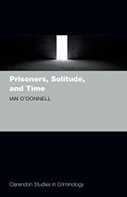Prisoners, Solitude, and Time

Author: Ian O’Donnell
Publisher: New York; Oxford, UK: Oxford University Press, 2014. 352p.
Reviewer: Sharon Shalev | September 2015
In Prisoners, Solitude and Time, Ian O’Donnell takes us on a broad and engaging tour of the temporal dimension of imprisonment. The focus is on the use of solitary confinement in prisons, though the book also looks at voluntary isolation, particularly in a monastic setting, and considers how time is negotiated in prison more generally.
O’Donnell starts with a brisk run through the history of solitary confinement in prisons, which begins in earnest in the 19th century, particularly through the prism of Eastern State Penitentiary in Philadelphia and Pentonville Prison in London. There are some interesting contentions and reflections here, including: how Dickens’ famously damning remarks on Eastern State may have coloured the subsequent debate; the reality of significant interaction between prisoners and staff (and visitors); and how a new level of organisation in prisons made the deranged easier to identify and record.
There are some telling facts that add colour and nuance to the 19th century ‘separate and silent’ prison experience. O’Donnell notes, for example, that in a single month in July 1861, the members of the Philadelphia Society for Alleviating the Miseries of Public Prisons interviewed prisoners in their cells at Eastern State on 612 occasions. Although O’Donnell paints perhaps too rosy a picture of the past, the extent and quality of human interaction is indeed key to the experience of solitary confinement. I should have liked to see the book pick up more clearly the issue of human interaction (or the lack thereof) in relation to contemporary isolation prisons.
The telling of the historical story is part of a wider corrective purpose of the book: to suggest that the effects of solitary confinement are more complex than often presented. Subsequent chapters review the different ways that people experience solitary confinement in various circumstances, for example, polar explorers and monks as well as prisoners. O’Donnell is clear that the morality of solitary confinement changes fundamentally if it is imposed rather than voluntary, and that it is more likely to be damaging in the former circumstances, but he sometimes goes to what, to my mind, are implausible lengths to find the virtues of solitude regardless. Surely for example it is a stretch too far to suggest that prison is a good place to enjoy ‘attunement to nature’.
Whilst sharing O’Donnell’s belief that the U.S. supermax prisons, covered in chapters 5 and 6, are wholly malign, I would also take issue with his assertion that their impact on prisoners is more nuanced than we might care to believe. I would give less credence than O’Donnell for example to the ‘Colorado Study’ (a longitudinal study of the psychological effects of segregation on prisoners in a Colorado supermax) . Accepting that studies of the health effects of supermax confinement are limited and suffer methodological difficulties, we should not fall back on the experience of few individuals to provide a basis for a wider conclusion about long term health impacts across the wider supermax population.
O’Donnell, citing Derek Jeffreys, quite rightly recognises that solitary confinement should not be critiqued solely on consequentialist considerations — we must ask ourselves first whether it is wrong in itself. That though does not stop O’Donnell marking down suggestions in the ‘plus column’ for administrative segregation: clarity of thought and improved functioning following trauma are, for example, posited as potential benefits in some circumstances.
This is in no way to suggest that this makes O’Donnell an apologist for solitary confinement, a practice he describes as ‘fundamentally inhumane’, and this is a point he is at pains to make himself.
Instead this book is intended as ‘a celebration of the human capacity to overcome even the most unprepossessing circumstances’ (p.77) and the stories of remarkable individuals we read about in its pages fully justify that claim.
It is surely no coincidence that the story told in most detail, and to which O’Donnell returns at the end of his book, is that of Clayton Fountain. Fountain, along with Thomas Silverstein, played a central role in the famous lockdown at Marion Prison in 1983, following the murder of prison guards there. After decades in extreme solitary confinement, Fountain at the time of his death was being admitted to a religious order, to share the hours and observances of the monks in the monastery nearby.
The links between the prison and the monastery are for O’Donnell close ones, and this is a book that looks at the experience of solitary confinement through the prism of a Christian monastic tradition. That clearly colours some of the judgments he makes. An atheist might draw some different conclusions, for example, on whether certain psychological changes should be seen as positive or negative ones. If voluntary solitude as a means of reaching closer to God is to be actively encouraged, then necessarily enforced solitude provides an opportunity alongside its perils. A non-believer might reasonably take a more jaundiced view.
Recognising that this book is written from a particular religious viewpoint in no way though detracts from the scholarly study of the relationship between time and imprisonment which is the focus of the final four chapters. Those are enriched by a wide range of personal accounts, illustrating aspects of O’Donnell’s thesis.
How prisoners negotiate time is, as O’Donnell asserts, a neglected area of study. It should not be, for ‘time has been taken away from them along with their freedom’ (p.177). The prisoner, particularly the long-term prisoner, must live in the present if they are to best cope with their sentence. The tumult of the first days and months in prison, characterised of course by significantly increased rates of suicide and attempted suicide, are associated with looking back to what has been lost; in the period before release the prisoner may similarly feel a new trepidation, characterised by looking forward to a life beyond the prison gate.
It may be easier to live in the present in between these two periods, but the prisoner is still faced with the tedium and pains of imprisonment, and with the challenge of ‘how to avoid serving time as a slave would its master’ (p.222). O’Donnell offers us some neat analysis of these issues. The ‘pain quotient’, a function of time to be served, divided by how much longer the prisoner might expect to live, seems a little too glib a notion. The seven ‘Rs’ of survival though, which are the focus of the penultimate chapter, represent a thoughtful synthesis of ways in which prisoners deal with time.
For O’Donnell, the seven ‘Rs’ of survival represent a hierarchy, from muddling through to mastery of time. Working upwards: Rescheduling involves managing and conceiving time in different blocks; Removal might entail reading, watching the television or physical exertion; Reduction is represented for example by sleeping as much as possible or drug use; Reorientation involves focussing on the present; Resistance is ‘beating the man’ [system]; Raptness is focussed absorption in goal-focussed activity; and Reinterpretation is extracting meaning from imprisonment, detachment and redefining one’s situation.
Perhaps, to add two more ‘Rs’, this analysis is a little too Romanticised and Rarefied. Considering that a large proportion of prison populations have limited literacy, high mental health needs, and a history of addiction, reaching the ‘higher Rs’ may be all but impossible. The debt to the contemplative and in particular Christian monastic tradition is again clear in this analysis, although not exclusive. Regardless of faith, ‘silence forces a confrontation with the self that seem to open new possibilities’ (p.269). What is in no doubt is that to get to the top of hierarchy of survival requires formidable mental fortitude.
The book is rich in first hand accounts of men and women who have shown extraordinary resilience in mastering appalling conditions of solitary confinement. It would be hard in the light of those stories to argue with O’Donnell’s view that ‘for some the experience [of prolonged isolation] is fortifying and even, occasionally, uplifting’ (p.271)
As O’Donnell though recognises, these are necessarily the stories of the literate survivors, of people who are likely to have considerable intellectual resources to accompany their mental fortitude. No-one should contemplate their triumphs over self without also remembering the many voiceless men and women crushed by solitary confinement. That is the narrative which must remain the dominant one.
O’Donnell is entirely correct to say of his book that ‘the penal hawk who finds succour in these pages is guilty of heroic self-deception’ (p.282). That doesn’t stop me worrying a bit that they nonetheless will if they read it selectively. That would be a shame on more than one count, because it’s an engaging, beautifully written book that merits careful reading. It is bold in its scope and full of ideas. Perhaps in consequence, there’s some blurring of the terms of the argument — voluntary and enforced solitary confinement; very different periods of solitary confinement; and solitary confinement and imprisonment more generally are sometimes bundled together to support the same conclusions. The Christian monastic tradition offers a particular perspective that colours some of those conclusions. I suspect that other readers who come to this text without — in particular Christian — faith, may, like me, not agree with them all. That though will, I hope, ensure this book generates some interesting debate around the use and abuse of solitary confinement, as its quality and breadth of scholarship merit.
Dr. Sharon Shalev, Research Associate, Centre for Criminology, University of Oxford


